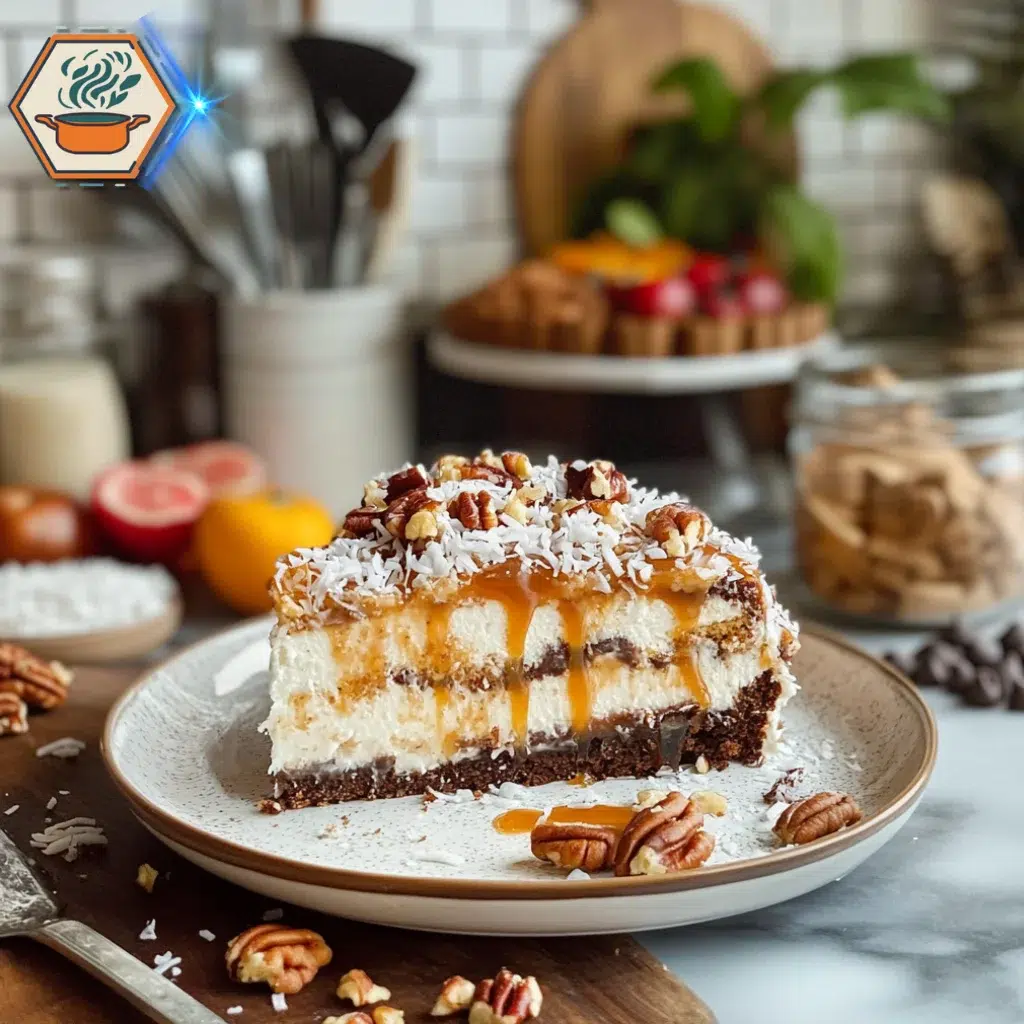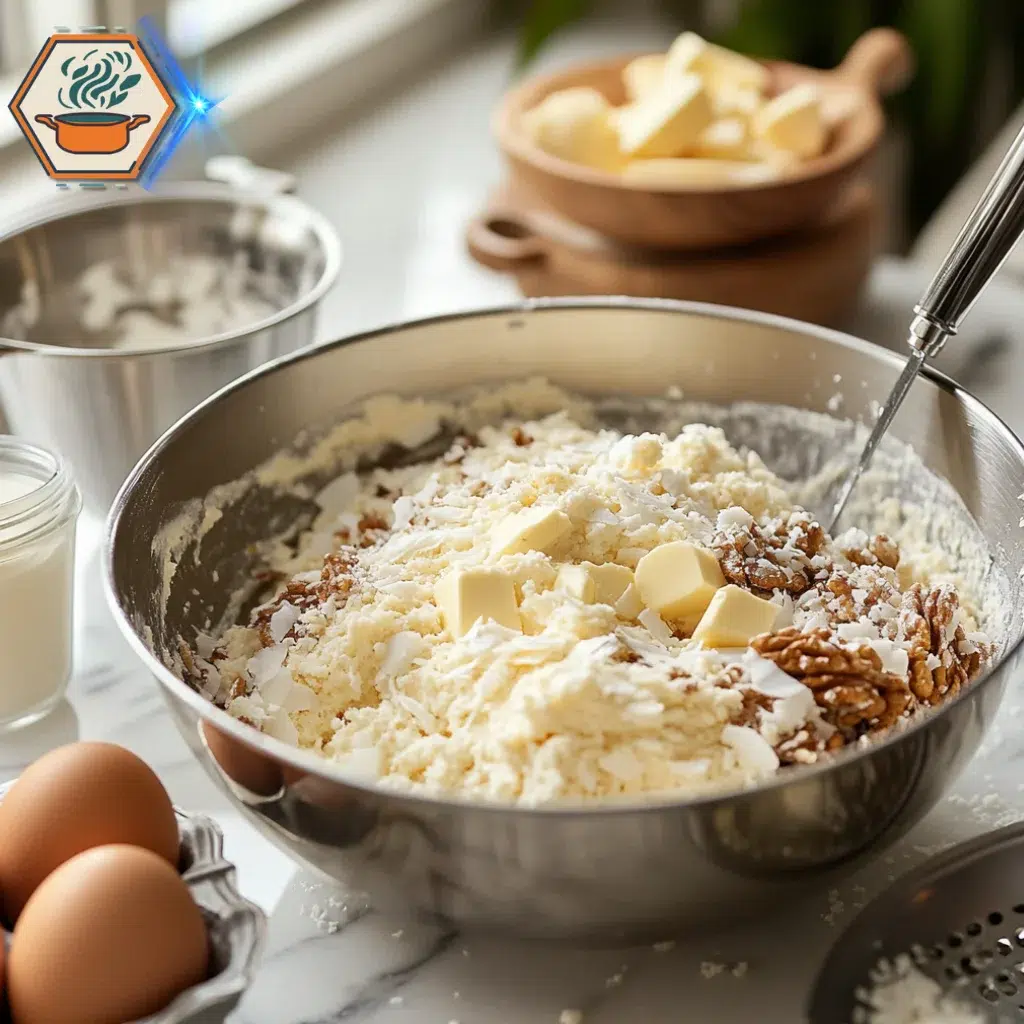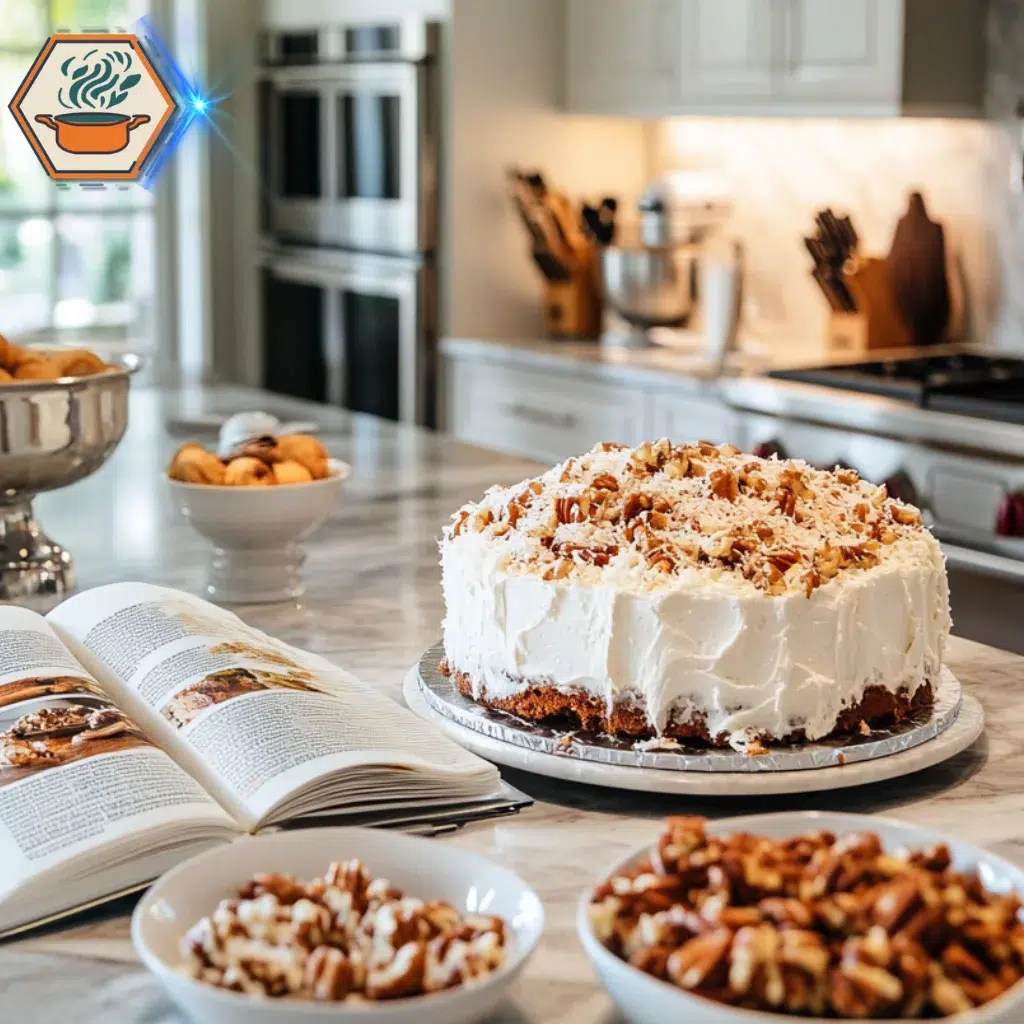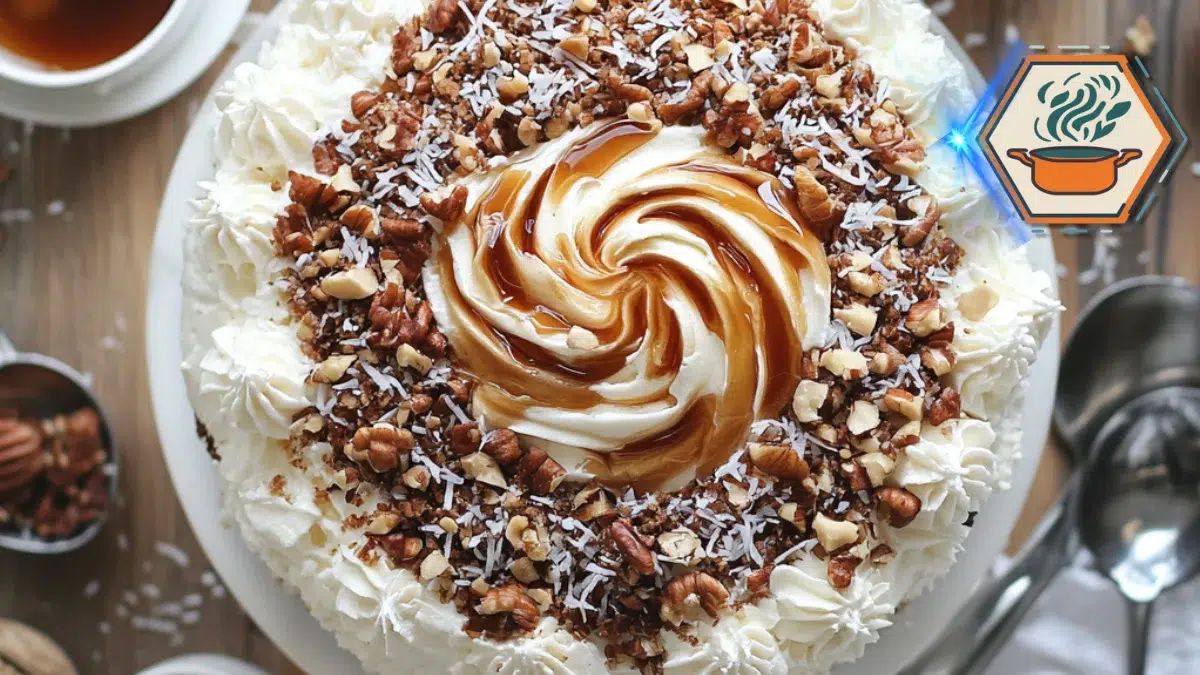Time to read:11 minutes
Table of Contents
The Origins and Significance of Hurricane Cake
What Is a Hurricane Cake?
A hurricane cake is a sweet, moist dessert made with simple ingredients like pineapple, coconut, and pecans. It’s often topped with creamy frosting, making it a favorite at family gatherings and potlucks.
But why is it called a hurricane cake? Some say the cake is so rich and indulgent that it “hits you like a hurricane.” Others believe the name comes from how quickly you can make it, perfect for last-minute events—just like preparing for a storm.
Tracing the Origins of Hurricane Cake
Where Did Hurricane Cake Come From?
The origins of the hurricane cake are not completely clear. Many believe it started in the Southern United States, where pecans and pineapple were common in desserts. These ingredients were easy to find, affordable, and added a tropical flavor to many dishes.
During the 1970s, cakes with similar ingredients became popular in community cookbooks. The simplicity of the recipe made it a hit at potlucks and parties. Over time, the hurricane cake gained its unique identity and became a go-to dessert for busy bakers.
For more about the history of cakes, check this Wikipedia article on cake history.
The Name “Hurricane Cake”
Why Is It Called a Hurricane Cake?
The name comes from the cake’s chaotic mix of flavors and textures. The pineapple gives it a juicy sweetness, the coconut adds a chewy texture, and the pecans give a crunchy bite. Together, these create a storm of flavors in every slice.
Another reason for the name is its ease of preparation. Like a hurricane, it comes together quickly and unexpectedly. Even with minimal effort, the result is a delicious dessert that’s perfect for any occasion.
Other Desserts with Fun Names
The hurricane cake isn’t the only dessert with a name inspired by nature. For example:
- Lava cake is named for its molten chocolate center.
- Earthquake cake has a cracked, uneven surface that looks like an earthquake hit it.
These names make desserts fun and memorable, and the Tropical Storm Cake fits perfectly in this category.
Popular Variations of Hurricane Cake

Regional Twists
Different regions have their own versions of the hurricane cake. In the South, bakers may use buttermilk to make it even more moist. In tropical areas, people sometimes add mango or passion fruit for a local twist.
Urban bakeries have also created unique versions. Some include chocolate chips or caramel drizzle for added sweetness. Vegan versions use flaxseed or applesauce instead of eggs.
Tropical Storm Cake and Other Desserts
The hurricane cake has similarities to other tropical desserts, like:
- Hummingbird cake with bananas and pineapple.
- Pineapple upside-down cake, which uses caramelized pineapple on top.
These desserts share the same tropical flavors and rich textures. To learn more about tropical dessert recipes, check out What is creme brulee made of?.
How to Serve Hurricane Cake
The hurricane cake is delicious on its own, but you can make it extra special by serving it with:
- Whipped cream.
- Vanilla ice cream.
- A cup of coffee or tea.
This versatile dessert works for any occasion, from casual dinners to holiday celebrations.
Ingredients and Recipe Breakdown
The Essential Ingredients of Hurricane Cake
To create a Hurricane Cake, you’ll need the following components:
- Margarine: Provides moisture and richness.
- Chopped Pecans: Add a crunchy texture and nutty flavor.
- Flaked Coconut: Offers a sweet, chewy element.
- German Chocolate Cake Mix: Serves as the base, delivering a deep chocolate taste.
- Water, Vegetable Oil, and Eggs: Combine to form the cake batter.
- Cream Cheese: Introduces a creamy, tangy layer.
- Confectioners’ Sugar: Sweetens the cream cheese mixture.
Each ingredient plays a vital role in achieving the cake’s unique flavor and texture.
Step-by-Step Instructions for Making Hurricane Cake

Follow these steps to bake your Hurricane Cake:
- Preheat the Oven: Set to 350°F (175°C).
- Prepare the Pan: Melt 1/2 cup of margarine and spread it evenly in a 9×13-inch baking pan.
- Add Coconut and Pecans: Sprinkle 1 cup each of flaked coconut and chopped pecans over the melted margarine.
- Prepare the Cake Batter: In a bowl, combine the German chocolate cake mix with 1 1/4 cups water, 1/2 cup vegetable oil, and 3 large eggs. Mix until smooth.
- Pour Batter into Pan: Evenly distribute the batter over the coconut and pecans.
- Prepare the Cream Cheese Mixture: In a saucepan over low heat, melt 8 ounces of cream cheese and the remaining 1/2 cup of margarine. Stir in 3 3/4 cups of confectioners’ sugar until smooth.
- Add Cream Cheese Mixture: Spoon the mixture over the cake batter in a random pattern.
- Bake: Place in the preheated oven and bake for 35 to 40 minutes, or until a toothpick inserted into the center comes out clean.
- Cool and Serve: Allow the cake to cool in the pan before serving.
For a visual guide, you can refer to reliable baking resources.
Common Substitutions for Tropical Storm Cake Ingredients
If you have dietary restrictions or lack certain ingredients, consider these alternatives:
- Margarine: Replace with equal parts butter or coconut oil.
- Pecans: Substitute with walnuts or almonds for a different nutty flavor.
- Flaked Coconut: Use shredded coconut or omit if preferred.
- German Chocolate Cake Mix: Opt for a standard chocolate cake mix if unavailable.
- Cream Cheese: Swap with a vegan cream cheese alternative for a dairy-free option.
For a comprehensive list of baking substitutions, consult resources like Real Simple’s baking substitutions chart.
Tips for Perfecting Your Tropical Storm Cake
To ensure your Hurricane Cake turns out perfectly:
- Measure Accurately: Use proper measuring tools for consistency.
- Room Temperature Ingredients: Ensure eggs and cream cheese are at room temperature for smoother mixing.
- Avoid Overmixing: Mix ingredients until just combined to prevent a dense cake.
- Check for Doneness: Use a toothpick to test; it should come out clean when the cake is done.
- Cool Properly: Let the cake cool in the pan to set its structure before serving.
By following these guidelines, you’ll achieve a moist and flavorful Hurricane Cake every time.
For more baking tips and recipes, explore our other articles, such as What is a pizza bite? and Substitute orzo for acini di pepe.
Nutritional and Cultural Impact of Hurricane Cake
Nutritional Insights of Hurricane Cake
Hurricane Cake is more than just a delightful dessert; it also has a nutritional profile that’s worth examining. Understanding its calorie content, sugar levels, and portion control can help you enjoy this treat responsibly.
- Calorie Count: A typical slice of Hurricane Cake contains approximately 350 to 400 calories, depending on the recipe variations. This makes it a calorie-dense dessert, so moderation is key.
- Sugar Content: Most recipes include about 1 cup of sugar, contributing to 25 grams or more per serving. For those watching their sugar intake, reducing the sugar or using alternatives like honey or stevia can help.
- Portion Recommendations: A standard serving size is about one small slice, roughly 100 grams. Pairing it with unsweetened beverages, such as tea or coffee, can balance the sweetness.
Tropical Storm Cake in Modern Celebrations

Hurricane Cake has found a special place in modern celebrations across cultures and occasions. Its versatility and rich flavors make it an ideal choice for various events.
- Festivals: This dessert is a showstopper at gatherings like Thanksgiving and Christmas. Its moist texture and rich flavor profile pair well with festive feasts.
- Birthdays: Adding a personal twist, such as flavored frostings or creative decorations, makes it popular for birthday parties.
- Special Events: Hurricane Cake is also a favorite at weddings and anniversaries, where it’s often presented in multi-layered or cupcake forms.
Discover more about sweet treats for celebrations in our article Is sweet potato pie good for you?.
The Growing Popularity of Hurricane Cake in the U.S.
The surge in Hurricane Cake’s popularity in the U.S. is due to several factors:
- Social Media Influence: Platforms like Instagram and TikTok have showcased innovative recipes and unique presentations, making this cake a trending topic.
- Accessibility: The ingredients are easy to source, and the recipe is beginner-friendly, appealing to home bakers.
- Cultural Appeal: The cake’s origins and history resonate with diverse audiences, adding an emotional connection to its indulgence.
Exploring Sustainable and Vegan Tropical Storm Cake Options
For eco-conscious bakers, modifying traditional Hurricane Cake recipes can make a big difference:
- Sustainable Ingredients: Opt for organic sugar, fair-trade chocolate, and locally sourced nuts. These choices support environmental sustainability.
- Vegan Alternatives: Replace eggs with flaxseed meal or applesauce. Use almond milk or coconut milk instead of dairy, and choose plant-based butter for a cruelty-free twist.
- Waste Reduction: Measure ingredients accurately to avoid waste, and consider composting leftover organic materials.
Frequently Asked Questions (FAQs)

Hurricane Cake has gained popularity not only for its unique name but also for its delightful combination of flavors and simplicity. Below, we address some of the most common questions surrounding this dessert.
Why Is It Called a Hurricane Cake?
The name Hurricane Cake might leave you wondering about its origin. It is believed that the cake gets its name due to the chaotic and unstructured way its ingredients are combined. Unlike traditional cakes that require precise mixing techniques, this cake is forgiving and easy to make, reflecting the unpredictable nature of a hurricane. Another theory ties the name to its birthplace, the southern United States, a region known for its tropical storms.
For more historical context, the name also resonates with the cake’s whirlwind of flavors – from crushed pineapples to sweetened coconut – which create a storm of taste in every bite. Learn more about similar flavorful desserts by exploring this guide to Southern recipes on Wikipedia.
Can I Substitute Ingredients for Tropical Storm Cake?
Yes! Substituting ingredients in Hurricane Cake is easy, making it suitable for various dietary preferences and restrictions. Here are some practical tips:
- Flour: Use gluten-free flour blends to make the cake celiac-friendly.
- Sugar: Swap refined sugar with alternatives like coconut sugar or stevia for a healthier version.
- Eggs: Replace eggs with flaxseed meal or unsweetened applesauce to make it vegan.
- Dairy: Substitute regular butter with plant-based margarine or coconut oil.
These adjustments ensure everyone can enjoy the cake without sacrificing its rich flavor or moist texture.
How Long Does Hurricane Cake Stay Fresh?
Hurricane Cake can stay fresh for up to five days when stored correctly. Follow these tips to maintain its quality:
- Room Temperature: If you plan to consume it within two days, store the cake in an airtight container at room temperature.
- Refrigeration: For a longer shelf life, refrigerate the cake. Ensure it’s wrapped tightly in plastic wrap to prevent it from drying out.
- Freezing: Freeze the cake for up to three months. Slice it into portions beforehand to make thawing easier.
For tips on keeping baked goods moist and fresh, check out our guide on how to keep madeleines moist.
What Are Some Fun Twists on the Traditional Hurricane Cake Recipe?
Personalizing Hurricane Cake is part of its charm. Here are some creative ideas:
- Add Spices: Enhance the flavor with cinnamon, nutmeg, or cardamom.
- Incorporate Nuts: Fold in chopped pecans or walnuts for added crunch.
- Switch the Fruits: Substitute pineapple with mango or peaches for a tropical variation.
- Top It Off: Experiment with frostings like cream cheese glaze or chocolate ganache.
- Healthier Options: Add chia seeds or shredded zucchini for a nutrient boost.
These twists make the cake more versatile and exciting, allowing bakers to create their signature version.
Is Tropical Storm Cake Easy for Beginners to Bake?
Absolutely! Hurricane Cake is one of the easiest desserts for beginners. The recipe’s lack of strict rules and straightforward ingredient list make it foolproof. Unlike other cakes that require careful folding or sifting, Hurricane Cake involves mixing everything in one bowl.
- Prep Time: Around 15 minutes
- Baking Time: 30-40 minutes
- Tools Needed: Basic baking equipment (mixing bowl, spatula, cake pan)
By following the recipe, even novice bakers can achieve a delicious result on their first try. If you’re looking to build your confidence in baking, Hurricane Cake is a great place to start.

